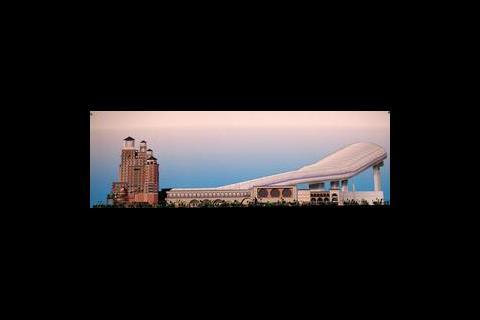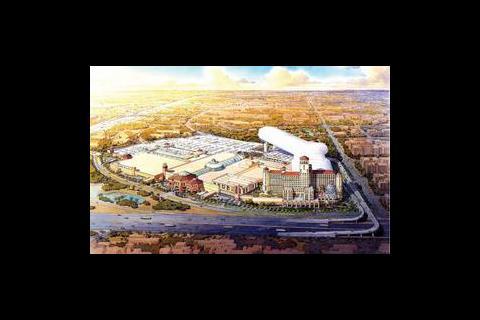Most people going to the desert city of Dubai wouldn’t think to pack their skis. But the creation of a huge snow centre, complete with five ski runs, is about to change all that.
It is not what you’d expect to find in the desert: an indoor winter sports resort with facilities for downhill skiers, snow boarders and ice skaters complete with an alpine village. But in the wired atmosphere of Dubai, where all developments seem to come with a moniker of the world’s biggest, the world’s tallest, the grandest, the most expensive … anything, it seems, is possible – even a ski slope.
The snow centre is the key to attracting people to the Mall of the Emirates. It contains a series of ski runs, including a challenging 200 m long black run, a snowboarding area, nursery slopes and a play area. At the foot of the ski slope, a full height glazed wall will give shoppers and occupants of the mall’s luxury hotel views of the skiers. Bizarrely, the presidential suites in the hotel even have “cold balconies” which overlook the ski slope. The task for the building’s designer, Acer Snowmech Consultants, was to design a building that will allow alpine sports in the desert.
To create the perfect skiing environment the temperature within the space must be carefully controlled. For the 16 hours of public use, the temperature is maintained just below freezing at -1.5ºC. Overnight, with the public out of the space, the snow is “groomed” ready for a new layer of fresh snow. A specially designed grooming machine removes the dirty snow from the surface of the slope and pushes it into a melting pit. During the four hours of grooming, the temperature is lowered still further to -6ºC ready for the four hours of snowmaking, where a 20 mm layer of crisp new snow is laid on the surface of the existing snow.
“The snow centre is basically a large cold-store lifted up at one end,” says Malcolm Clulow, chairman and managing director of Acer Snowmec Consulting. The building’s walls are lined with 125 mm thick coldstore insulation panels, finished in blue to hint at a brilliant alpine sky, and the panels for the ceiling are faceted to create an arch over the slope in an attempt mask the feeling that you are skiing in a box. The floor is insulated with 150 mm thick high density construction grade polystyrene, which is laid on a cold applied vapour seal. “At 170,000 m3 it’s one of the biggest refrigerators in the world,” jokes Clulow
Ensuring the walls are properly sealed is critical to the insulation’s performance. The walls are sealed on the warm side of the insulation to prevent condensation occurring within the insulation itself. Cold bridging is controlled through the use of non-conductive spacers, trace heating and insulation.
This insulated panel system is sheaved in an aluminium and GRP skin so that from the outside the snow centre resembles an aircraft wing. The over-cladding was essential in preventing the insulation panels bowing under the extreme desert heat and has a 50 mm layer of insulation to help reduce the temperature in the void between these two layers. Normally this void would be ventilated, but the fine talcum-powder like sand found locally would have found its way into the space. Instead, the void has been closed and localised cooling will be used to deal with any hot-spots.
Fresh air to the space is supplied at a rate of 4.5l/s per person. To cool this air to below freezing, a three stage cooling system is used. First the temperature is lowered using run-around coils, which transfer coolth from exhaust air to the fresh air. Then a chilled water coil removes humidity from the air and lowers its temperature to 10ºC using chilled water from the mall system. Finally, the air passes across one of a pair of low temperature coils (two coils, one on defrost while the other is cooling then swap over). Air is delivered at a very undesert-like temperature of -1.5°C.
Hyder Consulting, an equity partner in Acer Snowmec Consulting, designed the building’s structure. To keep the slopes clear of columns, the structure spans the 80 m wide lower and mid-slope sections. The top section is narrower but it has to bridge the 100 m from the mid-station to the top of the slope. This entire upper zone was constructed on the ground and strand jacked into position.
Fundamental to the centre’s success is the design of the ski slope. “It must be safe for users and yet provide enough variety to keep skiers returning,” says Clulow. So to develop the design Clulow teamed up with Konrad Bartelski, a British downhill skier, John Snedden, ex-technical director of the English Ski Council, and David Sterland, a snow centre developer and Ski Club of Great Britain guide.
The team’s final design incorporates left- and right-hand bends, a 60 degree bend and a mid-station where users can stop off at a cafe and, amazingly, warm themselves in front of a real fire. Five runs have been created, including a green run, a red run and a black run, which is a challenging 200 m long and 20 m wide, with 25 , 20 and 15 degree angles. There is also a 30 m long, 60 m wide nursery slope, snowboarding areas, an ice cavern, a snowball shooting gallery and avalanche effects – definitely not what you’d expect in the desert. n
How do you make snow in the desert?
The snow-making technology used in the Dubai snow centre was developed by Malcolm Clulow, chairman and managing director of Acer Snowmec Technology. “One of the biggest problems with making snow indoors is that at sub-zero temperatures the air does not hold much humidity,” he explains. This creates a problem for snow-guns. “Snow-guns don’t actually make snow, they simply atomise water and spray the fine droplets into the air,” says Clulow. “Droplets then turn into snow crystals in flight.”
The problem is that indoors, at low temperature, once a snow-gun is turned on, the air’s relative humidity rapidly rises to 100% (saturation). “Once this occurs, instead of a fluffy carpet of snow crystals you are left with a hard layer of blue ice,” Clulow says.
The size of the water droplets is critical to the quality of the snow generated. The snow-guns that are used on outdoor mountain ski slopes pump huge quantities of water droplets into the frozen mountain air. The droplets form spheres of about 250 microns in diameter, big enough to ensure they don’t get blown away in the wind and can survive a dousing of rain or a blast of sunshine. “As long as the plume from the snow guns does not reach saturation, the snow is okay for skiing, albeit a bit course and granular when viewed close up,” Clulow says.
He says that the snow in the snow centre will be the same as “wild snow”. Indoors there is no wind or rain; therefore the snow-guns can be set to produce liquid water particles in the range 10-50 microns. This creates realistic looking white powder snow that has the same volume to weight ratio as natural snow of 10 to one (10 volumes of snow from one volume of water). There is one snow-gun for every 1000 m2 of snow surface.
The real challenge in creating snow in the desert is the cooling needed to convert water into snow. The latent heat of fusion means that vast amounts of energy are needed to change a liquid into a solid. To cool 1 kg of water by 1ºC it takes 18.7 kJ of energy. To convert the same 1 kg of water into ice 335 kJ of energy must be removed. Therefore to cover an area of just 20,000 m2 of ski slope with 20 mm of fresh snow the cooling load would be: 20 000 m2 × 2 kg/m2 × 335 kJ/3600 seconds = 3722 kW of cooling.
Clulow says that snow generation would normally be carried out at night over a four-hour period. To install enough cooling plant to allow this to happen would create a huge capital cost. The genius of Clulow’s design is that it uses thermal storage to spread the cooling period over 24 hours rather than just four. So, using the example above, instead of having to provide 3722 kW of cooling per hour, approximately 600 kW per hour of cooling is generated and stored. “This represents an enormous capital and running cost saving not just for the snow making but for all the building’s heat gains,” says Clulow.
The thermal store is incorporated into the base of the ski slopes. More than 70 km of small-bore polyethylene pipes have been laid at 300 mm centres and buried in concrete. A special additive in the concrete ensures the concrete takes up coolth over the whole surface and that the concrete releases this coolth quickly when called for by the air chillers.
There are two refrigerant circuits: a primary ammonia circuit which is confined to the main plant space, and a secondary circuit containing a mixture of inhibited monoethylene glycol and water. The fluid in the secondary circuit circulates through the buried pipes at a temperature of between -10ºC and -20ºC to cool the floor.
When the time comes to make it snow, the glycol is piped up to 23 air coolers mounted in the slope’s roof void above the ski slope. Each air cooler cools the air adjacent to its dedicated snow-gun. These coolers are periodically defrosted using a warm glycol system heated by waste heat from the main cooling system.
Melted snow is filtered and recycled into the evaporative condensers for the shopping mall as free cooling.
Downloads
Thermal storage system
Other, Size 0 kb
Source
Building Sustainable Design
























No comments yet